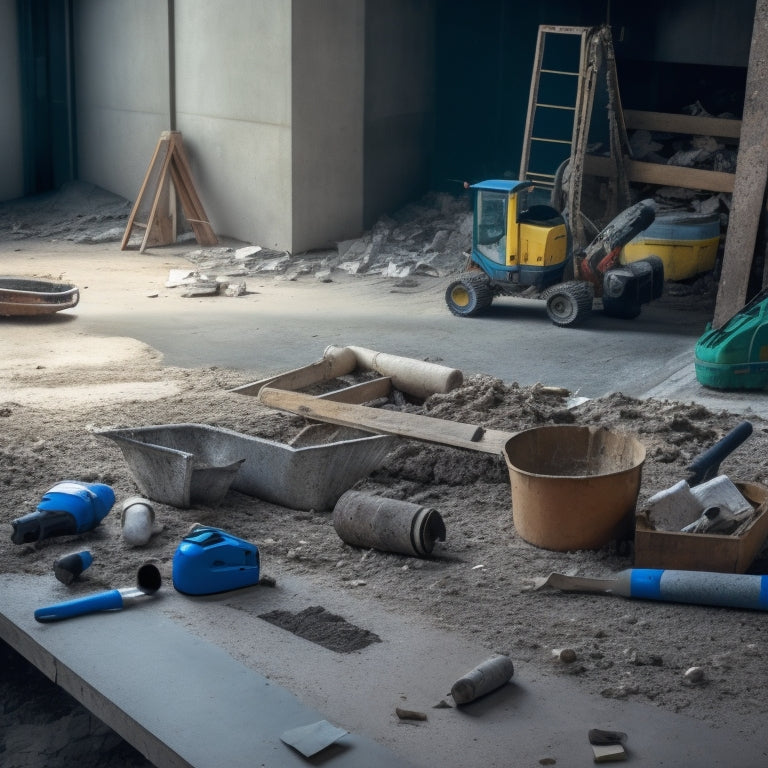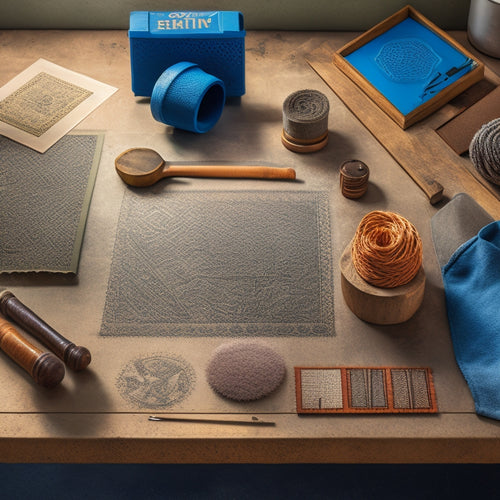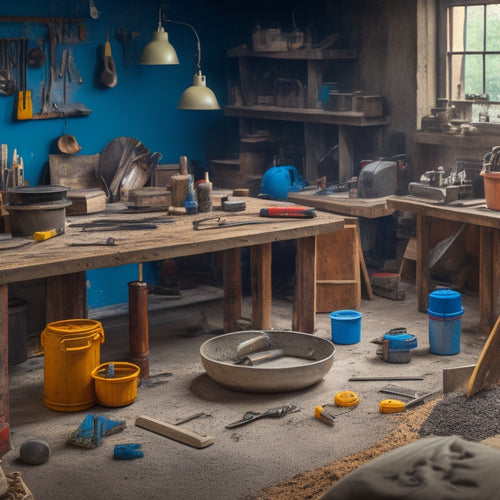
Why Choose the Right Concrete Filling Tools
Share
You'll want to choose the right concrete filling tools to guarantee precision application, a smooth finish, and durable bonding and adhesion. Slight deviations in density and flow rate can greatly affect the final product's quality, and proper tool selection is vital for achieving professional-grade repairs. With the right tools, you'll minimize surface roughness, secure maximum bonding potential, and select compatible filling materials for ideal results. By making informed tool choices, you'll streamline your workflow, reduce project timelines, and avoid costly rework - now, explore the essential factors that separate superior concrete filling tools from the rest.
Key Takeaways
• Choosing the right concrete filling tools ensures precise application, which is crucial for strength and durability of the final product.
• Selecting tools with compatible materials prevents project contamination and promotes efficient repairs.
• The right tools enable mastery of application techniques, enhancing precision and measurement accuracy.
• Optimal tool selection contributes to a smooth finish, minimizing surface roughness and imperfections.
• Using the correct tools with suitable filling materials expedites the process, reducing project timelines and enhancing productivity.
Importance of Precision Application
When you're working with concrete filling tools, achieving precision application is essential because even slight deviations from the specified density and flow rate can considerably impact the final product's strength, durability, and overall quality.
This is where mastering application techniques comes into play. You must guarantee that you're using the right tools for the job, and that you're skilled in their operation. Measurement accuracy is critical, as even minor discrepancies can have significant consequences.
To achieve precision application, you'll need to carefully calibrate your tools, guaranteeing that they're delivering the exact amount of concrete required. This may involve adjusting the flow rate, pressure, and temperature of the material, as well as monitoring its consistency and viscosity.
Ensuring a Smooth Finish
By mastering the art of precision application, you can now focus on guaranteeing a smooth finish, which requires careful attention to the concrete's surface texture, as even minor imperfections can compromise its overall appearance and performance.
To achieve a smooth finish, you'll need to employ advanced finish techniques that take into account the specific conditions of the concrete surface. This involves thorough surface preparation, including cleaning and degreasing the area, as well as identifying and addressing any cracks or imperfections.
Here are three key considerations to keep in mind:
-
Surface roughness: Guarantee that the concrete surface is level and even, with no rough patches or bumps that could interfere with the finish.
-
Moisture control: Regulate the moisture levels of the concrete to prevent excessive drying or shrinkage, which can lead to cracks and unevenness.
-
Finishing tools: Select the right finishing tools, such as trowels, floats, or edgers, that are designed for your specific concrete type and finish requirements.
Effective Crack Filling Methods
You must identify and address cracks in the concrete surface before applying a finish, as even the smallest imperfections can compromise the entire project's integrity. Conducting a thorough crack assessment is essential to determine the severity and extent of the damage. This will help you decide on the most effective filling method and material.
When it comes to filling cracks, you have two primary options: routing and filling, or applying a surface sealant. Routing and filling involves cutting out the cracked area, cleaning it, and then filling it with a concrete patching compound. This method is more labor-intensive but provides a stronger, more durable repair.
Surface sealants, on the other hand, are quick and easy to apply but may not provide a long-lasting solution.
The frequency of repair also plays a significant role in maintaining the concrete's integrity. Regular inspections and prompt repairs can prevent minor cracks from becoming major issues. By choosing the right filling tool and method, you can guarantee a strong, long-lasting repair that will withstand the test of time.
Durable Bonding and Adhesion
To guarantee a strong, long-lasting repair, the bonding and adhesion of the filling material to the concrete surface are just as essential as the filling method itself. You can't afford to overlook these vital aspects, as they directly impact the durability of the repair.
When you choose the right concrete filling tools, you'll secure a strong bond between the filling material and the concrete surface.
Here are three key considerations to achieve durable bonding and adhesion:
-
Surface preparation: Make sure the concrete surface is clean, dry, and free of contaminants to maximize bonding.
-
Bonding techniques: Select the most suitable bonding techniques for your specific application, such as mechanical bonding or chemical bonding.
-
Adhesion properties: Choose filling materials with ideal adhesion properties to guarantee a strong, long-lasting bond with the concrete surface.
Selecting the Right Materials
When selecting the right materials for your concrete filling tools, you'll want to evaluate the properties of both the filling material and the tool itself.
You'll need to choose a filling material that meets the specific requirements of your project, such as flowability, compressive strength, and durability.
Concrete Filling Material Options
Numerous concrete filling material options are available, each with its unique characteristics, advantages, and limitations. This makes it vital to carefully select the right material for your specific project requirements.
You need to take into account factors such as compressive strength, density, and flowability to guarantee the chosen material meets your project's demands.
When it comes to filling material types, you have several options to choose from:
-
Cementitious grouts: Suitable for structural repairs, these grouts offer high compressive strength and durability.
-
Epoxy-based grouts: Ideal for high-traffic areas, epoxy-based grouts provide excellent resistance to chemicals and abrasion.
-
Polyurethane foams: Used for void filling and insulation, polyurethane foams offer excellent flowability and expansion properties.
Each filling material type has its own application techniques, and it's important to understand these techniques to achieve the best results.
For instance, you may need to use specialized equipment, such as pumps or injectors, to apply certain materials.
Optimal Tool Material Selection
You'll need to pair your chosen filling material with the right tools to guarantee a successful concrete repair or restoration project, which is where ideal tool material selection comes into play. The primary concern here is material compatibility. You must ascertain that the tools you select won't react with or damage the filling material, compromising the entire project. For instance, if you're working with epoxy-based fillers, you'll need tools made from materials that won't contaminate or degrade the epoxy.
When selecting tool materials, prioritize tool durability. You want tools that can withstand the rigors of concrete filling without breaking or wearing down prematurely. Stainless steel, high-carbon steel, or fiberglass-reinforced tools are often ideal choices. These materials offer exceptional strength, resistance to corrosion, and durability, guaranteeing your tools remain functional throughout the project.
Additionally, consider the surface finish and texture of your tools, as these can affect the filling material's flow and finish. By choosing the right tool materials, you'll ascertain a smooth, efficient, and successful concrete repair or restoration project.
Time-Saving Filling Techniques
By mastering efficient concrete filling techniques, contractors can remarkably reduce project timelines and increase productivity. You can achieve this by adopting strategies that facilitate quick application and promote an efficient workflow.
Here are three techniques to get you started:
-
Layered Filling: Divide the filling process into manageable layers, allowing each layer to set before adding the next. This approach prevents excessive material buildup and reduces the risk of air pockets.
-
Sectional Filling: Divide the concrete surface into sections, filling each one at a time. This technique enables you to focus on a specific area, ensuring a uniform fill and minimizing material waste.
-
Pneumatic-Assisted Filling: Utilize pneumatic tools to accelerate the filling process. These tools can greatly reduce the time and effort required to fill large areas, making them ideal for large-scale projects.
Frequently Asked Questions
How Often Should I Clean and Maintain My Concrete Filling Tools?
You should establish a regular cleaning frequency for your concrete filling tools to prevent damage and guarantee peak performance.
Aim to clean your tools after every use, and perform deep maintenance every 1-2 weeks.
Check for worn-out parts, lubricate moving components, and store them in a dry place.
Can I Use the Same Tools for Different Types of Concrete Fillers?
You're wondering if you can use the same tools for different types of concrete fillers. The answer depends on tool compatibility and filler types.
Generally, it's not recommended to use the same tool for multiple fillers, as this can lead to cross-contamination and affect the filler's performance.
However, some tools are designed for versatility, so it's crucial to check the manufacturer's guidelines before switching between fillers.
Always prioritize compatibility to guarantee the best results and tool longevity.
What Safety Precautions Should I Take When Using Concrete Filling Tools?
When working with concrete filling tools, you're likely wondering what safety precautions to take.
Let's debunk the myth that concrete is a harmless material - it's not! In reality, it can be a hazardous substance if not handled properly.
You must take personal protective equipment (PPE) seriously, wearing gloves, safety glasses, and a dust mask to prevent skin and eye irritation.
Additionally, prioritize hazard awareness by identifying potential risks, such as trip hazards and electrical shock, to guarantee a safe working environment.
Are There Any Specific Storage Requirements for Concrete Filling Tools?
When you're not using your concrete filling tools, proper storage is essential to extend their tool lifespan.
You'll want to store them in a dry, climate-controlled area to minimize climate impact on the materials. Keep them away from direct sunlight, moisture, and extreme temperatures.
Clean and dry your tools before storing them in a protective case or container. This will prevent rust, corrosion, and damage, ensuring they remain in top condition for your next project.
Can I Rent or Borrow Concrete Filling Tools Instead of Buying Them?
When considering concrete filling tools, you might wonder if renting or borrowing is a viable option.
Before making a decision, you'll want to conduct a cost comparison. Calculate the rental or borrowing fees versus the cost of purchasing the tools outright.
Additionally, assess tool availability - will you have access to the tools when you need them? If not, owning the tools might be the better choice, ensuring you can meet project deadlines and maintain quality control.
Conclusion
You've made it to the final step in mastering the art of concrete filling - choosing the right tools for the job.
And let's be honest, it's a game-changer. With the right tools, you'll be filling cracks and holes like a pro, leaving a trail of flawless, durable surfaces in your wake.
It's like having a magic wand, waving away imperfections and leaving behind a concrete canvas that's virtually indestructible.
Don't settle for anything less - precision, durability, and a smooth finish are just a tool away.
Related Posts
-

5 Best Tools for Stamping Concrete Walls
When it comes to stamping concrete walls, you'll need a range of specialized tools to achieve the desired texture and...
-

Free Design Tools for Concrete House Planning
You can kick-start your concrete house planning project without breaking the bank, as there are several free design t...
-

Budget-Friendly Tools for DIY Decorative Concrete Profiling
You can achieve professional-grade decorative concrete results on a budget by investing in the right combination of e...


